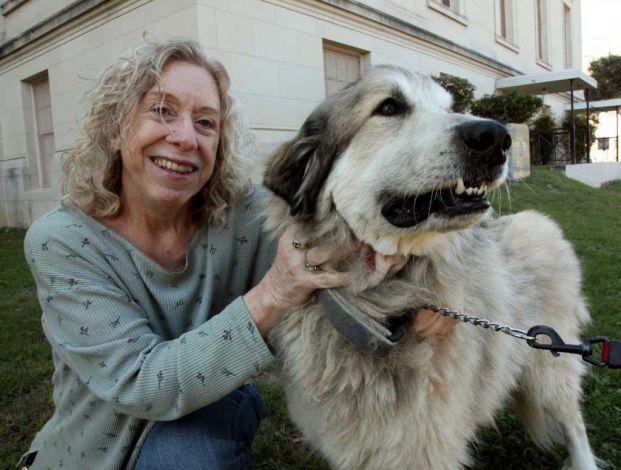
Kate Cordts with her dog Rowdy pose for a photo on November 17, 2011. Photo: SAN ANTONIO EXPRESS-NEWS, JUANITO GARZA / By Melissa Ludwig, mludwig@express-news.net
Portions of this article are reprinted under the Fair Use Doctrine covering news reporting and research. You may find the full article here. (From San Antonio Express News)
When Kate Cordts noticed swelling on the foreleg of her Great Pyrenees, Rowdy, she knew exactly what it was. Bone cancer.
“One of my previous dogs had the same disease. We had to put him down because it was too far along,” said Cordts, a librarian at the San Antonio Public Library.
A trip to the vet confirmed her suspicion, but this time she wasn’t ready to give up without a fight.
Putting her research skills to work, she found an experimental treatment at Texas A&M University’s veterinary school that could save her dog’s leg — and one day maybe the lives of children suffering from osteosarcoma, or bone cancer.
On Friday, Theresa Fossum, a veterinary surgeon at the Texas A&M Institute for Preclinical Studies in College Station, injected radioactive isotopes into Rowdy’s bone using tiny drills about the size of two human hairs. Researchers will watch the results carefully to see if the cancer shrinks and if the treatment could hold promise for humans.
“One of the reasons it costs $1.2 billion to get a new drug on the market is that most fail in clinical trials,” Fossum said. “Many get tested in mice with no immune system so they can grow a human tumor. Dogs are good models; they probably get cancer for the same reasons as humans and have an intact immune system.”
… Around 10,000 dogs a year develop osteosarcoma, which seems to favor large dogs like St. Bernards. The disease strikes about 900 humans each year in the U.S., many of them children under 15.








